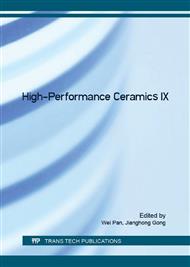p.652
p.658
p.664
p.670
p.675
p.680
p.685
p.691
p.695
ZrO2 Ceramic Composite Added with MgAl2O4: Thermal Shock Resistance and Corrosion Resistance in Molten Uranium
Abstract:
A kind of ceramic composite consisted of Mg-Y co-doped ZrO2 and MgAl2O4 was prepared as candidate material to replace the high destiny graphite crucible which was often used in nuclear industry. When the addition of MgAl2O4 was 7 wt%, samples with good thermal shock resistance were obtained. The obtained samples were tested up to 12 h in molten uranium, and no apparent cracks were found on the corrosion surface. Meanwhile, the corrosion rate decreased significantly from 30 mg·cm-2·h-1 to 3 mg·cm-2·h-1 as the corrosion time prolonged from 2 h to 12 h due to the formation of a protection layer consisted of UO2, Al3Zr2 and ZrC during the uranium corrosion test. These results suggested that the ceramic composite prepared in this study owned both good corrosion resistance to the molten uranium and thermal shock resistance at high temperatures,so it’s a high potential material to replace the high density graphite crucible in nuclear industry.
Info:
Periodical:
Pages:
675-679
Citation:
Online since:
July 2016
Authors:
Keywords:
Price:
Сopyright:
© 2016 Trans Tech Publications Ltd. All Rights Reserved
Share:
Citation:


